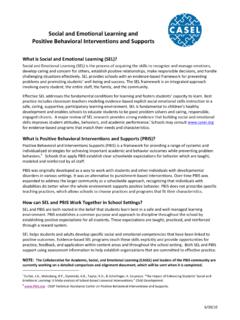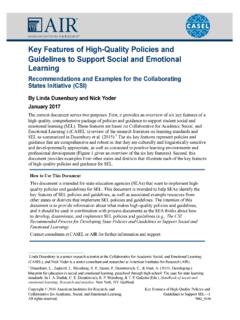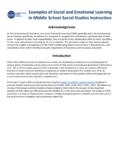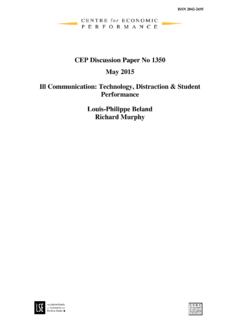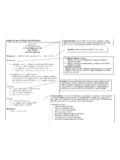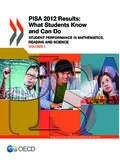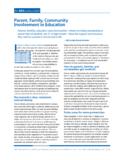Transcription of H S P (ESSA) S - Casel
1 A BRIEF FROM THE. COLLABORATIVE FOR ACADEMIC, SOCIAL, AND EMOTIONAL LEARNING ( Casel ). HOW STATE PLANNING FOR THE. EVERY STUDENT SUCCEEDS ACT (ESSA). CAN PROMOTE STUDENT ACADEMIC, SOCIAL, AND EMOTIONAL LEARNING: AN EXAMINATION OF FIVE KEY STRATEGIES. BY CHRISANNE L. GAYL. APRIL 2017. T he Every Student Succeeds Act (ESSA). provides an opportunity for states and local education agencies (LEAs) to rethink the goals and policies that they have in place for public education. Under the ers to focus more attention on this critical area of students ' development. This paper suggests five ways that policymakers can in- tegrate SEL approaches into their efforts and identifies strategies that have been new law, education leaders have greater proposed in several Consolidated State flexibility to define student success and to These examples are instructive for design their own systems and programs to states as they work to finalize their plans for ensure educational equity.
2 This paradigm submission to the Department of Edu- shift allows policymakers to develop com- cation by September 18, prehensive strategies that take into account all aspects of children's learning and devel- opment, including social-emotional skills, 1. Articulate a well-rounded vision of stu- that are instrumental for success in school dent success and in The first, and arguably most important, step Children's social and emotional develop- that policymakers can take when develop- ment has often been called the missing ing their ESSA plan is to articulate a compre- piece of America's education system. Yet a hensive vision of student success that en- large body of research shows that social compasses the multiple domains of stu- and emotional learning (SEL) approaches dents' development, including social and such as those that teach self-awareness, emotional development. States may define self-management, social awareness, rela- and describe SEL skills in different ways ( tionship skills, and responsible decision- nonacademic skills, whole child develop- making are associated with students ' ment, 21st-century competencies, etc.)
3 , but long-term academic and career success. SEL they all stem from an overall premise that interventions can be powerful components students need to be able to apply of positive school change. Studies have knowledge and skills to understand and identified benefits ranging from improved manage their emotions, set goals, build pos- classroom behavior, increased reading and itive relationships, and make responsible math achievement, higher graduation rates, decisions. Some states already have pre- and increased ability to handle school through grade three (PreK-3) or K-12. standards that address these skills. In addi- There is growing consensus among states, tion, all states have formally adopted early school districts, educators, and stakehold- 1 Durlak, , Weissberg, , Dymnicki, , Taylor, 3 Identified strategies have been proposed in various pub- , & Schellinger, (2011). The impact of enhancing licly available drafts of states' Consolidated State Plans as students ' social and emotional learning: A meta-analysis of of March school-based universal interventions.
4 Child Development, 4 Letter from Education Secretary DeVos to Chief 82(1), 405 432. State School Officers dated March 13, 2017 specified that 2 Ibid.; Osher, D. et al. (2016). Advancing the science and states may choose to submit their consolidated state plans practice of social and emotional learning: Looking back and either by April 3, 2017 or September 18, 2017. moving forward. Review of Research in Education, 1 38. Casel Brief ESSA and SEL: Five Strategies April 2017 Page 1. childhood standards that include social and academic standards and high expecta- emotional domains of tions for student Being able to articulate a comprehensive vi- In Massachusetts one of the core educa- sion for student success in the state's con- tional strategies is to support social-emo- solidated plan enables policymakers to de- tional learning, health, and safety. As a velop programs and systems that address result, the state is committed to building the multidimensional aspect of children's out supports and policies in partnership development.
5 The following states have with practitioners in the field and other outlined a strong vision as the foundation of state agencies to promote systems and their ESSA plans. strategies that foster safe, positive, healthy, culturally competent, and inclu- South Carolina's vision specifies that all sive learning environments and address students will graduate prepared for suc- students ' varied needs in order to im- cess in college, careers, and citizenship prove educational outcomes for all stu- and has developed the Profile of the dents. South Carolina Graduate as the basis of its This framework identifies the knowledge, skills, and life and career 2. Provide professional development to characteristics that each student should improve educator SEL capacity have upon graduation from high school, which includes self-direction, global per- In order to achieve a vision that values the spective, perseverance, and interpersonal social and emotional development of all skills that are important aspects of stu- students , educators must be able to effec- dents' social and emotional develop- tively integrate it into their everyday prac- ment.
6 Tice. students learn social-emotional com- petencies in the classroom when teachers Illinois has developed comprehensive model appropriate behavior and provide PreK-12 standards that reflect the state's them with opportunities to learn and apply vision of whole, healthy children nested such skills. The Center for Great Teachers in whole, healthy systems supporting and Leaders has identified 10 teacher prac- communities wherein all citizens are so- tices that support SEL, including:8. cially and economically secure. Through- out its plan there is a recognition of the 1. Student-centered discipline social, emotional, and behavioral needs 2. Teacher language that encourages stu- of students in addition to the challenging dent effort and work 5 States with K-3 SEL learning standards include: CT, ID, 8 Yoder, N. (2014). Teaching the whole child: Instructional OH, and WA, States with PreK-12 standards for SEL in- practices that support social-emotional learning in three clude: IL, KS, ME, MO, PA, VT, WV.
7 Teacher evaluation frameworks. Center on Great Teachers 6 and Leaders; American Institutes for Research at: essa/draft-consolidated-state-plan/ 7 Casel Brief ESSA and SEL: Five Strategies April 2017 Page 2. 3. Responsibility and choice given to stu- create and support an educator leader dents in the classroom network to connect leaders among dis- 4. Warmth and support shown by teachers and peers 5. Cooperative learning strategies, such as Massachusetts plans on sustained profes- supported group work sional development and collaborative 6. Classroom discussions learning around issues of cultural compe- 7. Self-reflection and self-assessment tency and SEL through guidance that it 8. An appropriate balance between direct has developed for administrators and instruction, group learning, and inde- school leaders on how to facilitate SEL as pendent work a schoolwide initiative. These materials 9. Academic press and high expectations include: PreK-K Social and Emotional for students Learning and Approaches to Play Learn- 10.
8 Competence building instruction in- ing Standards, Guidelines on Implement- cludes modeling, practicing, feedback, ing SEL Curricula, and Educator Effective- and coaching ness Guidebook for Inclusive Practice. ESSA provides multiple opportunities for Ohio plans to promote the integration of states and LEAs to offer systematic supports its existing K-3 standards for social and for teachers in these areas. New flexibility emotional learning into the regular in- within Title II, Part A, also allows LEAs to use structional practices and supports pro- funds for in-service training for school per- vided by school counselors, educators, sonnel in techniques and supports for refer- principals. and administrators through ring at-risk students to mental health ser- the development and delivery of profes- vices, as well as how to address issues such sional learning and resources to support as safety, peer interaction, drug and alcohol implementation.
9 Abuse, and chronic absenteeism. In their draft Consolidated Plans, states have pro- posed various strategies, including: 3. Identify evidence-based SEL interven- tions as a school improvement strategy Illinois proposes using Title II funds to build upon its resources for family and Evidence-based interventions that impact community engagement, SEL, cultural students ' social and emotional skills and de- competency, behavioral health issues, velopment can be powerful levers of and recognizing implicit bias, among change at the classroom or school level. Re- other issues. Educators will be able to ac- search shows that students who experience cess professional learning through its ed- these interventions demonstrate improved ucator dashboard, Ed360. In addition, the academic effort and achievement (as meas- state will use Title II and state funding to ured in reading, writing, and math tests).10. Including these practices as part of the 9 10 Sklad et al.
10 (2012); Dymnicki, Kendziora, & Osher. (2012); Taylor, Oberle, Durlak, & Weissberg (in press); Ba- varian et al. (2013); Jones, Brown, & Aber (2011); Rimm- Kaufman et al. (2014); Schonfeld et al. (2015). Casel Brief ESSA and SEL: Five Strategies April 2017 Page 3. state's or district's school improvement based best practices, supporting re- strategy is a powerful way of integrating SEL sources, on-demand guidance, and other into the everyday culture of schools. technical assistance to support effective execution and implementation. Under ESSA states must reserve seven per- cent of their Title I allocations11 to assist Connecticut will provide districts with a overall low-performing schools with com- template, guidance documents (with re- prehensive support and improvement, and quirements), and varied formats of train- schools with one or more subgroups of ing in completing the needs analysis pre- struggling students with targeted support ceding the LEA plan.

